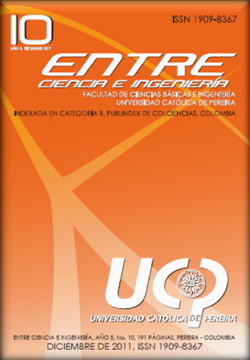Convertidores dc/dc en cascada para incremento de eficiencia y reducción de contenido armónico: Validación experimental.
Palabras clave:
DC/DC converter, boost converter, efficiency, current harmonicsResumen
Este artículo presenta la validación experimental de los beneficios ofrecidos por la conexión en cascada de convertidores dc/dc sobre los convertidores dc/dc clásicos. Los resultados obtenidos prueban que la conexión en cascada de convertidores dc/dc, a pesar de insertar resistencias parásitas adicionales, incrementa la relación de transformación de voltaje y la eficiencia de un sistema de conversión. Además, la configuración en cascada seleccionada reduce el contenido armónico inyectado a fuentes de potencia sensibles como pilas de combustible y paneles fotovoltaicos. Finalmente, se presenta un procedimiento simple para identificar experimentalmente la resistencia parásita del inductor en un convertidor elevador.
Referencias
Aranda, E. D., J. A. G. Galan, et al. (2009). Measuring the I-V Curve of PV Generators. IEEE Industrial Electronics Magazine 3(3), pp. 4-14.
Cabal, C., C. Alonso, et al. (2007). Adaptive Digital MPPT Control for Photovoltaic Applications. in IEEE International Symposium on Industrial Electronics, Vigo, Spain, pp. 2414-2419.
Erickson, R. W. and D. Maksimovic. (2001). Fundamentals of Power Electronics. Springer
Grandi, G., D. Casadei, et al. (2003). Direct Coupling of Power Active Filters with Photovoltaic Generation Systems with Improved MPPT capability. in IEEE Power Tech Conference, Bologna, pp. 23- 26.
Haynes, C. and W. J. Wepfer. (2001). Characterizing Heat Transfer within a Commercial-grade Tubular Solid Oxide Fuel Cell for Enhanced Thermal Management. International Journal of Hydrogen Energy 26(4), pp. 369-379.
Jang, S. J., C. Y. Won, et al. (2007). Fuel Cell Generation System with a new Active Clamping Current-fed Half-bridge Converter. IEEE Transactions on Energy Conversion 22(2), pp. 332-340.
Krein, P. T., R. S. Balog, et al. (2004). High-frequency Link Inverter for Fuel Cells based on Multiple-carrier pwm. IEEE Transactions on Power Electronincs 19(5), pp. 1279-1288.
Ramos-Paja, C. A., C. Bordons, et al. (2009). Minimum Fuel Consumption Strategy for PEM Fuel Cells. IEEE Transactions on Industrial Electronics 56(3), pp. 685-696.
Ramos-Paja, C. A., C. Carrejo, et al. (2010). A Ripple-mitigating Pre-filter Based on Interleaved DC-DC Boost Converters. in 36th Annual Conference on IEEE Industrial Electronics Society, Glendale, pp. 2771-2777.
W.A. Surdoval, S. C. Singhal, et al. (2001). The Solid State Energy Conversion Alliance SECA. in U.S. Department of Energy Initiative to Promote the Development of Mass Customized Solid Oxide Fuel Cells for Low-Cost Power, The 7th International Symposium on Solid Oxide Fuel Cells, Tsukuba, Japan, pp. 1-7.
Yu, Q., T. W. Holmes, et al. (2002). RF Equivalent Circuit Modeling of Ferrite-core Inductors and Characterization of Core Materials. IEEE Transactions on Electromagnetic Compatibility 44(1), pp. 258-262.




 <
<


 Revista Entre Ciencia e Ingeniería
Revista Entre Ciencia e Ingeniería .png) entrecei@ucp.edu.co
entrecei@ucp.edu.co.png) ISSN (Impreso) 1909-8367 - ISSN (En Línea) 2539-4169
ISSN (Impreso) 1909-8367 - ISSN (En Línea) 2539-4169 Attribution-NonCommercial 4.0 International (CC By-NC 4.0)
Attribution-NonCommercial 4.0 International (CC By-NC 4.0)
.png) Carrera 21 No. 49-95 Av. de las Américas, Pereira, Risaralda, Colombia
Carrera 21 No. 49-95 Av. de las Américas, Pereira, Risaralda, Colombia